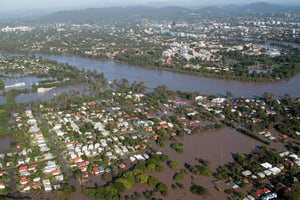In the first article on this topic, questions were posed on our climate related challenges, our understanding and approach to these, and whether we have changed our thinking and recorded what has been happening and considered what may happen. Are we better informed and prepared to anticipate, absorb, adapt to, and/or rapidly recover from such events?
In this article, a set of case studies from a joint Queensland Department of Transport and Main Roads and ARRB National Assets Centre of Excellence (NACOE) research project related to the rain and flood events across Queensland between 2010 and 2013, are used to illustrate the potential life cycle impacts of such events, with alternative proactive asset preservation and renewal strategies, and infrastructure enhancement responses investigated. The aim was to identify solutions which provide greater resilience to the road transport network, with these needing to be justified accounting for costs to the community and industry, and the road agency. A blanket approach of access at any cost is clearly unaffordable, and therefore a targeted approach and strategic response is necessary.
The areal extent of the rain and flood events is shown by the locations of the projects which made up the Transport Network Rehabilitation Program (TNRP) (bottom left), this being the infrastructure response to the events. They were widespread and represent areas which are frequently impacted by tropical cyclones and lows directly, and the semi-arid and arid central and western regions where significantly higher than normal rainfall and riverine and overland flow from the eastern ranges increases moisture loads. In many areas reactive, expansive clays (with high swell and shrinkage potential) are widespread (coloured in beige below). Case studies were selected from across the State (bottom right) representing different parts of the network, covering vastly different traffic levels and road density (including the availability of alternative routes) and strategic importance.


The scenarios and options investigated included:
- Extreme event frequency, representing periodic events varying from 5 to 15 (normal) and 25-year intervals with these acting as ‘shocks’, meaning almost complete failure on vulnerable sections if not entire routes, with gradual deterioration occurring in the intervening period.
- Business as usual (as it happened) and proactive responses ensuring an effective asset preservation approach using ‘stitch in time’ principles, simple drainage measures, etc., or full resilience where significant investment was assumed to elevate the road and provide a quality of pavement which could resist high moisture loads under most circumstances.
Building and analysing the case studies involved:
- Collecting data on the rain/flood events and the TNRP response
- Developing an analysis methodology and case study selection criteria for a suite of cases
- Investigating gradual deterioration and recurrence cycles of extreme events
- Considering preventative and full resilience strategies as alternatives to a reactive strategy
- Accounting for disruption, i.e. reduced access, and lower journey speed, during period of disruption and rebuilding
The overall picture representing the sum of individual project benefits (transport cost savings) from employing the different strategies and considering the recurrence interval of extreme events is shown opposite. The challenge is, whereas a blanket response shows that ‘stitch-in-time’ is the most beneficial approach, although reducing in its effectiveness as recurrence interval shortens, high value / volume routes are exposed leading to significant economic losses.

Considering a targeted response where strategies reflect the best (lowest Total Transport Cost) solution per route type and importance, offered a more pragmatic solution as shown below, with a strong recommendation to invest in advance of as opposed to awaiting further events. This benefits the community and industry, avoids expensive renewal and replacement works and breaks the ‘boom and bust’ cycle of high-cost reactive projects and programs. The preferred approach was shown to deliver a significant ‘bang for buck’ (or marginal benefit cost ratio) of 3 or more if applied across the network.

To find out more, contact Tyrone Toole via tyronet@arrb.com.au.
